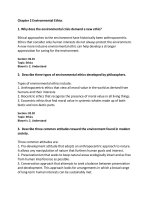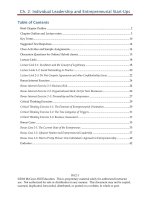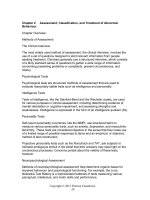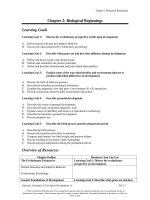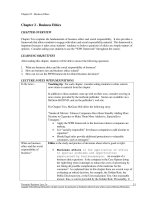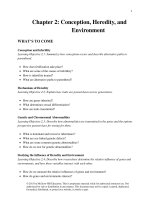Test bank and solution manual of ch02 individual leadership and entrepreneurship start up (1)
Bạn đang xem bản rút gọn của tài liệu. Xem và tải ngay bản đầy đủ của tài liệu tại đây (671.42 KB, 42 trang )
Ch. 2: Individual Leadership and Entrepreneurial Start-Ups
Table of Contents
Brief Chapter Outline ............................................................................................................................ 2
Chapter Outline and Lecture notes ..................................................................................................... 3
Key Terms ............................................................................................................................................. 10
Suggested Text Responses .................................................................................................................. 14
Class Activities and Sample Assignments........................................................................................ 14
Discussion Questions for Online/Hybrid classes ........................................................................... 15
Lecture Links ........................................................................................................................................ 18
Lecture Link 2-1: Incubators and the Concept of Legitimacy ................................................................. 18
Lecture Links 2-2: Social Networking in Practice .................................................................................. 20
Lecture Link 2-3: Do Not Compete Agreements and other Confidentiality Issues ................................ 22
Bonus Internet Exercises ..................................................................................................................... 24
Bonus Internet Exercise 2-1: Business Risk ........................................................................................... 24
Bonus Internet Exercise 2-2: Organizational Slack: Not for New Businesses ....................................... 26
Bonus Internet Exercise 2–3: Personality and the Entrepreneur ........................................................... 27
Critical Thinking Exercises ................................................................................................................. 29
Critical Thinking Exercise 2-1: The Elements of Entrepreneurial Orientation ..................................... 29
Critical Thinking Exercise 2-2: The Two Categories of Triggers ........................................................... 31
Critical Thinking Exercise 2-3: Business Assessment ............................................................................ 33
Bonus Cases .......................................................................................................................................... 35
Bonus Case 2-1: The Current State of the Entrepreneur ........................................................................ 35
Bonus Case 2-2: Lifesaver Realtor and Entrepreneurial Leadership ...................................................... 37
Bonus Case 2-3: Paint a Pretty Picture: One Individual’s Approach to Entrepreneurship .................. 40
Endnotes ................................................................................................................................................ 42
IM 2-1
©2016 McGraw-Hill Education. This is proprietary material solely for authorized instructor
use. Not authorized for sale or distribution in any manner. This document may not be copied,
scanned, duplicated, forwarded, distributed, or posted on a website, in whole or part.
Ch. 2: Individual Leadership and Entrepreneurial Start-Ups
Brief Chapter Outline
I.
Learning Objectives (text page 19).
Explain how entrepreneurial founders impact the business world as a whole
Discuss the importance of an entrepreneurial orientation
List the triggers that encourage new business formations
Compare and contrast various types of new business supports
Explain how you can evaluate those things that you enjoy the most and
discover how they may lead to business opportunities
II.
Founders are the Reason Why Entrepreneurial Business Works So Well (text
pages 23 through 24)
Learning Objective 2-1: Explain how entrepreneurial business founders impact
the business world as a whole
III.
Evaluating Your Entrepreneurial Orientation (text pages 23 through 27)
Learning Objective 2-2: Discuss the importance of an entrepreneurial orientation
IV.
Triggers for Starting a Business (text pages 27 through 28)
Learning Objective 2-3: List the triggers that encourage new business formations
V.
Supports (text pages 29 through 33)
Learning Objective 2-4: Compare and contrast various types of new business
supports
VI.
Form a Business Doing What You Like (text pages 33 through 34)
Learning Objective 2–5: Explain how you can evaluate those things that you
enjoy the most and discover how they may lead to business opportunities
VII.
Summary (text page 34)
IM 2-2
©2016 McGraw-Hill Education. This is proprietary material solely for authorized instructor
use. Not authorized for sale or distribution in any manner. This document may not be copied,
scanned, duplicated, forwarded, distributed, or posted on a website, in whole or part.
Ch. 2: Individual Leadership and Entrepreneurial Start-Ups
Chapter Outline and Lecture notes
1. Learning Objectives (text page 19).
Explain how entrepreneurial business founders impact the business world as a
whole
Discuss the importance of an entrepreneurial orientation
List the triggers that encourage new business formations
Compare and contrast various types of new business supports
Explain how you can evaluate those things that you enjoy the most and discover
how they may lead to business opportunities
2. Founders Are the Reason Why Entrepreneurial Business Works So Well
Learning Objective 2-1: Explain how entrepreneurial business founders impact
the business world as a whole
a. New businesses have advantages that larger businesses do not have
i. New businesses
1. Increased flexibility compared to a larger businesses
because the entrepreneur can respond quicker to changes,
opportunities, and threats in a business environment
2. It is typical for new business founders to capture niche
markets
3. The most important and notable advantage for a new
business is the founder of the new business is both a
manager and an owner
4. Entrepreneurs in new businesses are dedicated to their work
ii. Large businesses
1. Multiple committees in large businesses prevent them from a
quick response time to changes, opportunities, and threats in
a business environment
2. Large firms do not have a competitive advantage in niche
markets because they can’t afford to compete with smaller
firms
3. A major disadvantage in large businesses is that the
managers do not have ownership in the business. As a
IM 2-3
©2016 McGraw-Hill Education. This is proprietary material solely for authorized instructor
use. Not authorized for sale or distribution in any manner. This document may not be copied,
scanned, duplicated, forwarded, distributed, or posted on a website, in whole or part.
Ch. 2: Individual Leadership and Entrepreneurial Start-Ups
result, they do not have any substantial stock ownership in
the firm
b. Agency theory is a management theory that argues that individuals act to
maximize their own benefit
i. In large organizations it is typical for the manager to perform for
their personal benefit and not the greater good of the firm
ii. In small organizations it is typical for the entrepreneur to perform for
the greater good of the firm
3. Evaluating Your Entrepreneurial Orientation (text pages 23 through 27)
Learning Objective 2-2: Discuss the importance of an entrepreneurial orientation
a. Entrepreneurs need to consider the three elements of entrepreneurial
orientation before they open a new business (text page 23)
i. Risk tolerance
1. Risk tolerance is the amount of risk an entrepreneur is willing
to assume when they start a new business
2. Break-even point
a. The point when a new business has reached a level
where revenue coming into the firm is sufficient to
cover expenses.
ii. Prior experience
1. Bounded rationality is rational decision making that is
constrained by the background and history of the decision
maker
a. Bounded rationality promotes future leaders because
they are not limited by past experiences
iii. Personality orientation of the individual
1. Personality orientation occurs when an individual examines
their individual personality
2. The extroverted and outgoing entrepreneur performs better
in a business environment that has extensive interpersonal
interactions
3. The introverted entrepreneur performs better in a business
environment that has limited interpersonal interactions
IM 2-4
©2016 McGraw-Hill Education. This is proprietary material solely for authorized instructor
use. Not authorized for sale or distribution in any manner. This document may not be copied,
scanned, duplicated, forwarded, distributed, or posted on a website, in whole or part.
Ch. 2: Individual Leadership and Entrepreneurial Start-Ups
4. Personality tests evaluate the factors in the environment that
sparked an interest that led the entrepreneur to start a new
business
5. Three popular tests include the Myers-Briggs test, the
Enneagram, and the Big Five test
a. The Myers-Briggs test focuses on the following four
variables
i. Extroversion-introversion focuses on an
outward or internal variable
ii. Sensing-intuiting focuses on how individuals
gather data
iii. Thinking-feeling focuses on how people make
decisions
iv. Judgment-perception focuses on order versus
flexibility
b. The Enneagram test evaluates the following nine
different personality types
i. Reformer refers to the idealist/perfectionist
personality
ii. Helper refers to the caring/good interpersonal
skills
iii. Achiever refers to the competent/driven
individual
iv. Individualist refers to the sensitive/dramatic
personality type
v. Investigator refers to the cerebral/focused
individual
vi. Loyalist refers to the committed/pessimistic
individual
vii. Enthusiast refers to the fun-loving/impatient
individual
viii. Peacemaker refers to the easygoing/passive
aggressive individual
ix. Challenger refers to the action oriented, cynical
individual.
c. The Big Five test emerged as a result of data analysis
and it explores the following personality traits
i. Open-mindedness
IM 2-5
©2016 McGraw-Hill Education. This is proprietary material solely for authorized instructor
use. Not authorized for sale or distribution in any manner. This document may not be copied,
scanned, duplicated, forwarded, distributed, or posted on a website, in whole or part.
Ch. 2: Individual Leadership and Entrepreneurial Start-Ups
ii. Conscientiousness
iii. Agreeableness
iv. Emotional stability
v. Extroversion
6. Ask students to evaluate their personality using one of these
personality tests
4. Triggers for Starting a Business (text pages 27 though 28
Learning Objective 2-3: List the triggers that encourage new business formations
a. Triggers are a result of positive or negative stimuli that encourage an
individual or group to initiate a new business
i. Loss of employment
ii. Inspired to establish business by other individuals or groups
iii. Tolerable levels of risk and return
iv. Financial security
v. Innovative ideas that inspire improvement
vi. Inspired by books, entrepreneurs, or seminars
vii. Life changes associated with crisis
viii. Observations of incubator or business development in community
ix. Employed by a firm with no growth potential
1. Did not graduate from an ivy league college
2. Women entrepreneurs initiate new businesses
3. The glass ceiling : Women are unable to climb the corporate
ladder in a male-dominated industry or corporation
4. Women entrepreneurs represent the fastest growing
segment of entrepreneurs
5. Incorrect job fit
b. Triggers are categorized by personal motivations and circumstance
motivations
i. Personal motivations are the strongest motivations
1. Motivated to change career
2. Proactive
3. Goal driven
4. Circumstance motivations result in defense positioning
a. Opportunities for potential entrepreneurs present
themselves as a result of the environment
IM 2-6
©2016 McGraw-Hill Education. This is proprietary material solely for authorized instructor
use. Not authorized for sale or distribution in any manner. This document may not be copied,
scanned, duplicated, forwarded, distributed, or posted on a website, in whole or part.
Ch. 2: Individual Leadership and Entrepreneurial Start-Ups
b. Motivated by start-up opportunities from competing
factors
c. Examples of circumstance motivations
d. Laid-off or displaced worker
e. Demoted from a prestigious position
f. Employed at a reduced or discounted pay
g. More flexibility in their lives and families
5. Supports (text pages 29 through 33)
Learning objective 2-4: Compare and contrast various types of new business
supports
a. Entrepreneurs have many support and resources available to assist them
with their small business needs
b. Supports are unique to the individual entrepreneur
c. Supports are unique to the entrepreneur’s geographical location
d. Examples of supports include family, networks, community, and financial
support
i. Family
1. Ask students to create a list of close family members and
compose a list of the capabilities those individuals posses
that might provide support to the new business (text page
29)
2. New business owners and future entrepreneurs utilize all
resources from their family
3. New businesses are often referred to as a family business
a. The key staff and decision makers in the business
consist of family members
b. Compared to a non-family-owned business the longterm management of a family business is unique
c. There are flexible payroll options in a family business
d. The level of commitment in a family-owned business
far exceeds that of a non-family-owned small
business
e. It is possible for a family business to have negative
outcomes
IM 2-7
©2016 McGraw-Hill Education. This is proprietary material solely for authorized instructor
use. Not authorized for sale or distribution in any manner. This document may not be copied,
scanned, duplicated, forwarded, distributed, or posted on a website, in whole or part.
Ch. 2: Individual Leadership and Entrepreneurial Start-Ups
i. It is difficult to fire or reprimand a family
member
ii. A family member could make negative verbal
comments that a regular employee would not
make
iii. Nepotism can cause negative outcomes to the
other employees
iv. Ask students to discuss the pros and cons
related to a family-operated business
4. Networks
a. Networks provide key support resources to
entrepreneurs
b. Former employees are a good network resource
c. Individuals from fraternal organizations are potential
network resources
d. School organizations provide possible network
resources
e. Other organizations that provide potential network
resources are churches or synagogues
f. Good network resources can prevent corruption and
fraud
g. Good network resources establish legitimacy
h. Blogs and chat rooms from other similar businesses
can be a source of advice.
i. Crowd sourcing sites such as Kickstarter.com and
Crowdfunder.com reach out to a wide community
online to get funding and advice.
5. Community
a. The community provides supports that can help
prevent or reduce the level or risk for a new business
b. An incubator is a facility that houses the new business
and provides essential services. New businesses are
expected to develop and leave the facility often within
18 months of founding.
i. Examples include
1. Office machines
2. Office Furniture
3. Telephones
IM 2-8
©2016 McGraw-Hill Education. This is proprietary material solely for authorized instructor
use. Not authorized for sale or distribution in any manner. This document may not be copied,
scanned, duplicated, forwarded, distributed, or posted on a website, in whole or part.
Ch. 2: Individual Leadership and Entrepreneurial Start-Ups
4. Fax machines
5. Copy machines
6. Other maintenance needs for new
business
c. The business incubator provides essential services to
assist the new business with their start-up and
continued business needs
i. Receptionist at a centralized location helps to
build credibility for the new business
ii. Offers space to tenant firms at subsidized rates
iii. Small Business Assistance Centers are
centers that are funded by the Small Business
Administration (SBA) that advise individuals
with their new business at no cost.
1. Assist the firm with funding resources
2. Counseling services provided by retired
executives
6. Financial support
a. Entrepreneurs must understand the cost/benefit of the
new business
b. Entrepreneurs must utilize financial resources
c. Entrepreneurs must be able to have a broad
understanding of what financial resources are
available and a realistic idea of what will be needed to
expend.
6. Form a Business Doing What You Like (text pages 33 through 34)
Learning Objective 2-5: Explain how you can evaluate those things that you
enjoy the most and discover how they may lead to business opportunities
a. The successful entrepreneurs enjoy their work
b. The time/reward relationship in a new business involves more than a
financial reward
7. For Review (text pages 34-35)
IM 2-9
©2016 McGraw-Hill Education. This is proprietary material solely for authorized instructor
use. Not authorized for sale or distribution in any manner. This document may not be copied,
scanned, duplicated, forwarded, distributed, or posted on a website, in whole or part.
Ch. 2: Individual Leadership and Entrepreneurial Start-Ups
Key Terms
Agency Theory: A managerial theory that believes individuals act to maximize their
own benefit. Thus, in settings where there is a split between ownership and control (as
in most publicly traded corporations) the agents (managers) must be monitored or they
ill act to maximize their own benefit, not necessarily that of those who own the firm (the
shareholders). (LO 2-1)
Bounded Rationality: Rational decision making that is constrained by the background
and history of the person making the decision. (LO 2-2)
Break-even Point: The time when a new business has reached a level where revenue
coming into the firm is sufficient to cover expenses. (LO 2-2)
Incubator: A facility that houses new businesses and provides many critical services for
them. New businesses are expected to develop and typically leave the facility often
within 18 months of founding. (LO 2-4)
Organizational Slack: Excess resources in an organization that allow for redundancy
and the quick deployment of personnel in crisis. (LO 2-1)
Small Business Assistance Centers: Centers funded by the Small Business
Administration that provide free advice to individuals wishing to start new businesses.
(LO 2-4)
IM 2-10
©2016 McGraw-Hill Education. This is proprietary material solely for authorized instructor
use. Not authorized for sale or distribution in any manner. This document may not be copied,
scanned, duplicated, forwarded, distributed, or posted on a website, in whole or part.
Ch. 2: Individual Leadership and Entrepreneurial Start-Ups
Suggested Text Responses
Opening Vignette – Philly Pretzel and Dan Dizio
Student responses will vary.
Exercise 1 – Page 22
Student responses will vary.
Exercise 2 – Page 23
Student responses will vary.
Exercise 3 – Page 24
Student responses will vary.
Ethical Challenge – Page 27
Student responses will vary.
Exercise 4 – Page 33
Student responses will vary.
Exercise 5 – Page 34
Student responses will vary.
IM 2-11
©2016 McGraw-Hill Education. This is proprietary material solely for authorized instructor
use. Not authorized for sale or distribution in any manner. This document may not be copied,
scanned, duplicated, forwarded, distributed, or posted on a website, in whole or part.
Ch. 2: Individual Leadership and Entrepreneurial Start-Ups
Review Questions – Page 34
1. How does the lack of “slack” resources impact new ventures?
The new firm has limited flexibility in responding to issues such as the need to hire
replacements if the company loses key individuals.
2. Why is founder involvement in a new venture so critical to its success?
Because the founder has substantial ownership in the company, the founder always
acts to maximize the value of the business. If the business makes money, the owner
makes money.
3. Is there a minimum level of risk tolerance required to start a business? Explain.
Entrepreneurs should never do anything that does not allow them to sleep at night.
4. How does bounded rationality affect the way an entrepreneur determines what
type of business to start?
The individual brings his or her own view of the world to the business. This view places
boundaries on what decision maker will consider as she or he makes decisions. These
boundaries are set by experiences, history, culture, and family values.
5. How do you think personality differences matter in the starting of a business?
Outgoing and extroverted personalities may wish to focus on a business with extensive
interpersonal interactions. More introverted personalities may with wish to focus on
businesses in which interpersonal interactions are more limited such as web based
companies.
IM 2-12
©2016 McGraw-Hill Education. This is proprietary material solely for authorized instructor
use. Not authorized for sale or distribution in any manner. This document may not be copied,
scanned, duplicated, forwarded, distributed, or posted on a website, in whole or part.
Ch. 2: Individual Leadership and Entrepreneurial Start-Ups
6. List some triggers that push people into starting a business.
Being laid off; being approached with a business idea; reaching a tolerable risk level;
receiving evidence that an idea is doable; attending a seminar reading a book; talking to
other entrepreneurs; unable to climb the corporate ladder.
7. Have you experience any of these triggers?
starting your own business?
Did it cause you to consider
Student responses will vary.
8. Which supports do you believe you might rely on the most if you started your
own business?
Supports could include family, networks and community.
IM 2-13
©2016 McGraw-Hill Education. This is proprietary material solely for authorized instructor
use. Not authorized for sale or distribution in any manner. This document may not be copied,
scanned, duplicated, forwarded, distributed, or posted on a website, in whole or part.
Ch. 2: Individual Leadership and Entrepreneurial Start-Ups
Class Activities and Sample Assignments
1. Divide the class into groups of two or three students. Ask students to choose a
business and list their individual risk tolerances. As a group, discuss the cumulative
risks associated with a potential new business if the students in each group were
partners in that new business. Next, ask the students to analyze the results and
decide if they should initiate the new business. Why or why not? (LO 2-2)
2. Ask students to define organizational slack. Discuss whether or not organizational
slack is abundant in an entrepreneurial business or a large business. Why? (LO 21)
3. Divide the class into groups of two or three students. Ask each group to define
bounded rationality and list their individual assessment of bounded rationality.
Discuss how bounded rationality can enhance leadership because individuals are
not limited by some past experiences. (LO 2-2)
4. In groups, ask students to discuss the key differences in the outcomes of the MyersBriggs test, the Enneagram, and the Big Five test. Which test would they prefer in
their new business? Why? (LO 2-2)
5. Ask the students to discuss their individual likes and dislikes related to opportunities
for a new business. Next, ask students if they would consider opening a new
business that offered a product that they did not like for the sole purpose that it
generated a tremendous amount of profit. Discuss whether or not that new business
would be successful over a long period of time. (LO 2-5)
6. Ask students to consider the various supports and resources that are available to
them as potential entrepreneurs and list the ones that they think are more important
and explain why. Ask students to support their various responses with specific
examples. (LO 2-4)
7. Ask students to consider the triggers that would enhance their motivation and
increase their efforts to focus on a new business venture. List the triggers on a flip
chart and discuss why it is motivational. (LO 2-3)
IM 2-14
©2016 McGraw-Hill Education. This is proprietary material solely for authorized instructor
use. Not authorized for sale or distribution in any manner. This document may not be copied,
scanned, duplicated, forwarded, distributed, or posted on a website, in whole or part.
Ch. 2: Individual Leadership and Entrepreneurial Start-Ups
Discussion Questions for Online/Hybrid classes
1. Discuss the similarities and differences between entrepreneurial businesses and
large businesses. (LO 2-1)
2. Explain the advantages and disadvantages of new business entrepreneurship? (LO
2-1)
3. Compare and contrast the behavior of entrepreneurs versus the behavior of large
corporate executives. Why are entrepreneurs more dedicated to their businesses?
(LO 2-1)
4. Why is it important for potential entrepreneurs to have a personality that
compliments their interest in a potential new business opportunity? Why should
entrepreneurs enjoy their work? (LO 2-2 and LO 2-5)
5. What is risk tolerance? Why should potential entrepreneurs analyze their risk
tolerance? (LO 2-2)
6. Consider the reasons why potential entrepreneurs decide to pursue
entrepreneurship. Compare and contrast personal motivations with circumstance
motivations. Discuss what motivates you to consider entrepreneurship. (LO 2-3)
7. Why are minority women-owned firms so popular? In your opinion, does the glassceiling exist? Do you believe that it is a barrier that prevents women from promotions
to executive-level positions in corporate America? (LO 2-3)
8. If you were a potential entrepreneur, what supports and resources would you use to
enhance your new business? Explain why they are important to the success of your
new business. (LO 2-4)
9. Suppose you are a new entrepreneur and you hired several family members to fill
key positions vacant at your new business. Discuss the ethical issues that might
arise between the employees that are relatives and the other employees that work at
your new business? (LO 2-4)
10. What is a business incubator? How do they assist entrepreneurs with new business
startups? (LO 2-4)
IM 2-15
©2016 McGraw-Hill Education. This is proprietary material solely for authorized instructor
use. Not authorized for sale or distribution in any manner. This document may not be copied,
scanned, duplicated, forwarded, distributed, or posted on a website, in whole or part.
Ch. 2: Individual Leadership and Entrepreneurial Start-Ups
Discussion Questions for Online/Hybrid classes- Responses
1. Discuss the similarities and differences between entrepreneurial
businesses and large businesses. (LO 2-1) In a large business, no one
person is critical to the business but in an entrepreneurial business the
success of the business depends on the founder. Large businesses also
have a wide dispersion of knowledge among the employees but an
entrepreneurial business relies on the founder with possibly a few
employees. Large businesses usually have more financial resources than
small businesses.
2. Explain the advantages and disadvantages of new business
entrepreneurship? (LO 2-1) Entrepreneurial businesses have greater
flexibility, can respond quickly to changes and can fill niches that large
businesses can’t afford to fill. Large firms have the advantage of economies
of scale and a depth of knowledge among its employees.
3. Compare and contrast the behavior of entrepreneurs versus the
behavior of large corporate executives. Why are entrepreneurs more
dedicated to their businesses? (LO 2-1) Managers in large businesses
tend to act for his or her own benefit whereas the founder acts to maximize
the value of the business.
4. Why is it important for potential entrepreneurs to have a personality
that compliments their interest in a potential new business
opportunity? Why should entrepreneurs enjoy their work? (LO 2-2 and
LO 2-5) The potential entrepreneur will be involved with the business 24/7 so
a person whose personality doesn’t fit or who isn’t happy will not succeed.
5. What is risk tolerance? Why should potential entrepreneurs analyze
their risk tolerance? (LO 2-2) Potential entrepreneurs need to determine
their personal willingness to accept risk and let that information help them
with their decision.
6. Consider the reasons why potential entrepreneurs decide to pursue
entrepreneurship. Compare and contrast personal motivations with
circumstance motivations. Discuss what motivates you to consider
entrepreneurship. (LO 2-3) Personal motivations come from the
individuals themselves and drive people to make career and life-altering
moves. Entrepreneurs driven by personal motivation will be more proactive
and drive relentlessly toward their goals.
IM 2-16
©2016 McGraw-Hill Education. This is proprietary material solely for authorized instructor
use. Not authorized for sale or distribution in any manner. This document may not be copied,
scanned, duplicated, forwarded, distributed, or posted on a website, in whole or part.
Ch. 2: Individual Leadership and Entrepreneurial Start-Ups
7. Why are minority women-owned firms so popular? In your opinion,
does the glass-ceiling exist? Do you believe that it is a barrier that
prevents women from promotions to executive-level positions in
corporate America? (LO 2-3) Many women find their career opportunities
blocked by the glass ceiling and become entrepreneurs.
8. If you were a potential entrepreneur, what supports and resources
would you use to enhance your new business? Explain why they are
important to the success of your new business. (LO 2-4) Student
responses will vary but could include family, networks, and community.
9. Suppose you are a new entrepreneur and you hired several family
members to fill key positions vacant at your new business. Discuss the
ethical issues that might arise between the employees that are relatives
and the other employees that work at your new business. (LO 2-4)
Responses will vary but could include conflicts among family members,
problems with firing a family member, and issues with other employees who
are not family members.
10. What is a business incubator? How do they assist entrepreneurs with
new business startups? (LO 2-4) A business incubator is a facility that
house new businesses and provides many critical services for the new
ventures. Many new businesses cannot afford a receptionist, space, or other
equipment.
IM 2-17
©2016 McGraw-Hill Education. This is proprietary material solely for authorized instructor
use. Not authorized for sale or distribution in any manner. This document may not be copied,
scanned, duplicated, forwarded, distributed, or posted on a website, in whole or part.
Ch. 2: Individual Leadership and Entrepreneurial Start-Ups
Lecture Links
Lecture Link 2-1: Incubators and the Concept of Legitimacy
(LO 2-4)
New business owners must consider many options when they plan to implement the
new business. Acknowledge that you generated your innovative business idea, now it is
time to analyze what type of support you require to get the operation up and running.
Recall from the text that an incubator is a facility that houses the new business and they
provide the essential service for your new start up and the need that are required to
continue your business.
Perhaps you do not have the funding that is required to purchase the essential tools and
equipment outright to start the business. You could start it up in the basement, the
garage, or your home office. However, consider how a potential investor or partner
might view that operation. A new business owner wants to assure their business
projects a level of legitimacy not only for investors and potential partners, but for the
purpose of projecting a legitimate and trusted business.
Assume that you have already established your business and in your analysis you
realize that you require a business incubator for the business. Conduct research on the
internet to find a business incubator firm in your area and complete the questions listed
below.
Discussion Questions:
1. Summarize the results of your research for a business incubator in your area.
What was the outcome of your research? Be specific.
2. What type of products and services did the companies offer? Were they
reasonably priced?
3. Which business incubator would you choose for your new business needs?
Provide specific reasons and explain why.
4. Discuss the products and services that you will utilize from the service and why
you believe those are the products or services that you need. Be specific.
IM 2-18
©2016 McGraw-Hill Education. This is proprietary material solely for authorized instructor
use. Not authorized for sale or distribution in any manner. This document may not be copied,
scanned, duplicated, forwarded, distributed, or posted on a website, in whole or part.
Ch. 2: Individual Leadership and Entrepreneurial Start-Ups
Lecture Link 2-1: Incubators and the Concept of Legitimacy (LO 2-4)-Notes
Student responses will vary.
IM 2-19
©2016 McGraw-Hill Education. This is proprietary material solely for authorized instructor
use. Not authorized for sale or distribution in any manner. This document may not be copied,
scanned, duplicated, forwarded, distributed, or posted on a website, in whole or part.
Ch. 2: Individual Leadership and Entrepreneurial Start-Ups
Lecture Links 2-2: Social Networking in Practice
(LO 2-4)
Many new business owners contemplate about the techniques they will use to assure
they network to receive the support they require to promote and develop their new
business initiatives. Networking is important for a variety of reasons. In the text, you
learned that networks provide key support resources to entrepreneurs. In addition,
individuals from various sources in the community offer support that assist new
business owners to pursue their new business goals.
The internet provides a variety of social networking resources that business owners can
join to achieve their network goals. Analyze the various resources that are available to
entrepreneurs. Consider the type of networks that you will utilize to promote your
business. Conduct research and discuss the following questions:
1. List ten social network resources for entrepreneurs to consider for their new
business.
2. Compare and contrast the features and benefits of these resources. Discuss the
advantages of each resource. Be specific.
3. Discuss which social networking web sites that you would consider to join. Why?
IM 2-20
©2016 McGraw-Hill Education. This is proprietary material solely for authorized instructor
use. Not authorized for sale or distribution in any manner. This document may not be copied,
scanned, duplicated, forwarded, distributed, or posted on a website, in whole or part.
Ch. 2: Individual Leadership and Entrepreneurial Start-Ups
Lecture Links 2-2: Social Networking in Practice (LO 2-4)-Notes
1. List ten social network resources for entrepreneurs to consider for their
new business. Social networking sites are constantly changing so the students
answers may vary. Some examples may include LinkedIn, Facebook, Twitter,
Instagram, Craig’s List, Google+.
2. Compare and contrast the features and benefits of these resources.
Discuss the advantages of each resource. Be specific. Student’s response
will vary.
3. Discuss which social networking web sites that you would consider to join.
Why? Student responses will vary.
IM 2-21
©2016 McGraw-Hill Education. This is proprietary material solely for authorized instructor
use. Not authorized for sale or distribution in any manner. This document may not be copied,
scanned, duplicated, forwarded, distributed, or posted on a website, in whole or part.
Ch. 2: Individual Leadership and Entrepreneurial Start-Ups
Lecture Link 2-3: Do Not Compete Agreements and other Confidentiality Issues
(LO 2-3)
Entrepreneurs consider many details when they implement their new business ideas,
development, planning, and of course goals. In the ethical challenge case presented by
the authors, you observed an ethical decision that an employee had to make about
taking a client list prior to her departure from the company.
Generally, many businesses today ask employees to sign confidentiality agreements,
do not compete, and other non disclosure documents during their tenure. Typically,
these documents forbid employees from removing client lists, competing with clients
after they leave the company for a specified period of time, and other specific
stipulations against these actions. In addition, a company could choose to have these
documents drawn up by an attorney or another professional. The purpose is to prevent
individuals from taking business away from the company.
Conduct research on the internet to search for do not compete agreements, non
disclosure agreements, and confidentiality agreements.
Discussion Questions:
1. Summarize the outcome of your research. What did you discover about noncompete agreements and confidentiality agreements? What legal issues are
involved?
2. Discuss what you might do as a new business owner to prevent individuals from
removing client lists or other confidential data. What type of documents will you
consider enforcing as an entrepreneur?
3. Discuss the outcome of not implementing these types of agreements for your
new business.
4. Discuss the actions that you would take as a new business owner if an employee
endorsed a confidentiality agreement and took a client list regardless of the
agreement. What are your options? Be specific.
IM 2-22
©2016 McGraw-Hill Education. This is proprietary material solely for authorized instructor
use. Not authorized for sale or distribution in any manner. This document may not be copied,
scanned, duplicated, forwarded, distributed, or posted on a website, in whole or part.
Ch. 2: Individual Leadership and Entrepreneurial Start-Ups
Lecture Link 2-3: Do Not Compete Agreements and other Confidentiality Issues
(LO 2-3)-Notes
Discussion Questions:
1. Summarize the outcome of your research. What did you discover about
non-compete agreements and confidentiality agreements? What legal
issues are involved? A non- compete agreement is an agreement where one
party agrees not to start a similar business within a certain area. There are
usually term limits to the agreement. A confidentiality agreement is an
agreement where an employee or contractor agrees not to disclose any
information about the business. The language needs to be specific. However, in
some cases, a court may decide that such an agreement may impede the
livelihood of a person and such an agreement may not uphold in court.
2. Discuss what you might do as a new business owner to prevent individuals
from removing client lists or other confidential data. What type of
documents will you consider enforcing as an entrepreneur? Both a noncompete agreement and confidentiality agreement may help prevent an
individual from removing confidential data. A new business owner needs to be
careful with confidential information and who he trusts with it.
3. Discuss the outcome of not implementing these types of agreements for
your new business. Not having such an agreement may allow a former
employee to open a similar competing business nearby.
4. Discuss the actions that you would take as a new business owner if an
employee endorsed a confidentiality agreement and took a client list
regardless of the agreement. What are your options? Be specific. This
situation is why a new business owner needs to have a working relationship with
a good attorney who can guide him. The new business owner can sue but this
usually involves a long, expensive process.
IM 2-23
©2016 McGraw-Hill Education. This is proprietary material solely for authorized instructor
use. Not authorized for sale or distribution in any manner. This document may not be copied,
scanned, duplicated, forwarded, distributed, or posted on a website, in whole or part.
Ch. 2: Individual Leadership and Entrepreneurial Start-Ups
Bonus Internet Exercises
Bonus Internet Exercise 2-1: Business Risk
(LO 2-4)
In this chapter we discussed that risk tolerance is one of the three elements of
entrepreneurial orientation. It was defined as the amount of risk a new business is
willing to assume when they implement their new business.
Assume that you already established your new business. Next, perform a search on the
internet to discover various types of business risks. In the search engine, type in
“business risk” and review some articles or web sites that discuss the various types of
business risk and answer the following questions.
1. Describe your business. What types of business risk did you discover in your
research? List at least five types of business risk and document the web site that
you used.
2. Discuss each risk and summarize how that risk might adversely affect your new
business.
3. What could you do to mitigate that risk? Be specific.
IM 2-24
©2016 McGraw-Hill Education. This is proprietary material solely for authorized instructor
use. Not authorized for sale or distribution in any manner. This document may not be copied,
scanned, duplicated, forwarded, distributed, or posted on a website, in whole or part.
Ch. 2: Individual Leadership and Entrepreneurial Start-Ups
Bonus Internet Exercise 2-1: Business Risk Notes
(LO 2-5)
The answers from the students will vary. According to a recent article at Forbes.com i
the following risks were discussed:
1.
2.
3.
4.
5.
6.
7.
Credit
Legal
Regulatory
Operational
Hiccups
Concentration risk
You
Students are encouraged to discuss their new business and discuss what they
would do to limit business risk and assure their new business is successful.
IM 2-25
©2016 McGraw-Hill Education. This is proprietary material solely for authorized instructor
use. Not authorized for sale or distribution in any manner. This document may not be copied,
scanned, duplicated, forwarded, distributed, or posted on a website, in whole or part.
